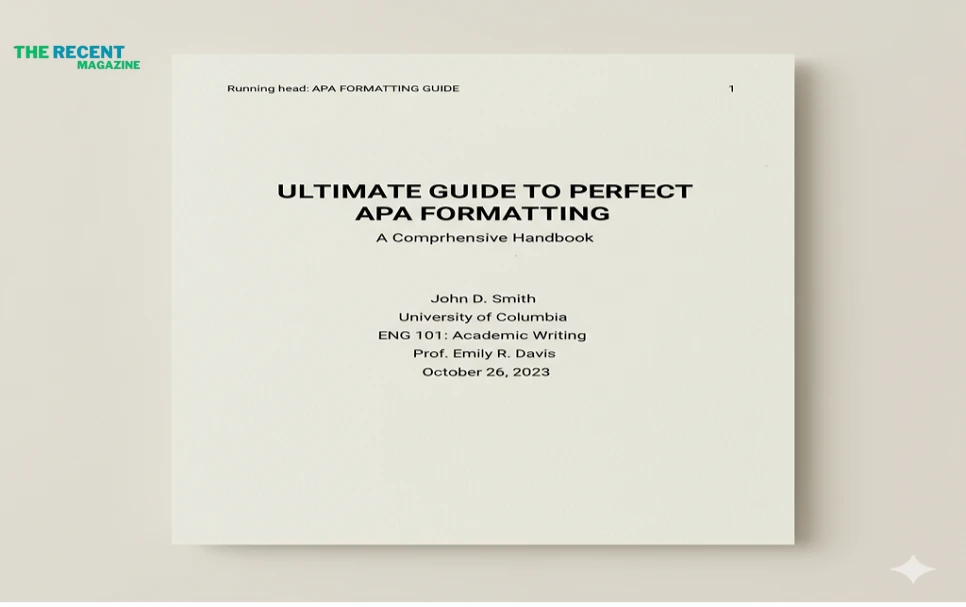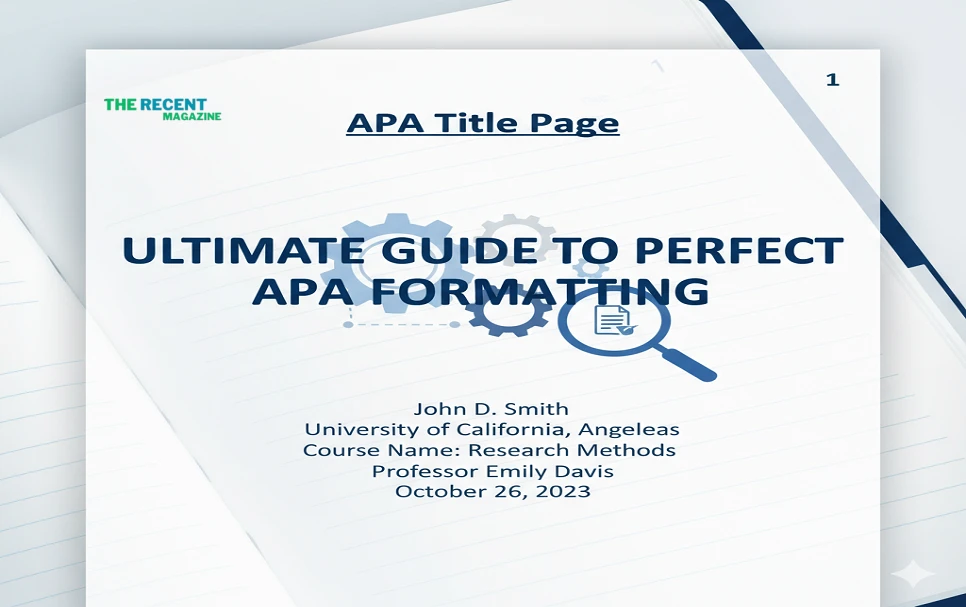Now Reading: Apa Title Page: Ultimate Guide to Perfect APA Formatting
-
01
Apa Title Page: Ultimate Guide to Perfect APA Formatting
Apa Title Page: Ultimate Guide to Perfect APA Formatting

Are you struggling with how to create the perfect APA title page for your paper? You’re not alone.
Getting your title page right can feel tricky, but it’s the first step to making a strong impression on your readers and instructors. Your APA title page is more than just a cover—it sets the tone for your entire work and shows that you understand the rules of academic writing.
You’ll discover simple, clear steps to format your APA title page exactly as required. By the end, you’ll feel confident that your paper starts off on the right foot, grabbing attention and meeting all the standards. Keep reading to learn how to make your title page stand out with ease!
Title Page Basics
The title page in APA style gives the first impression of your paper. It shows the title, author’s name, and affiliation. It helps readers know the paper’s topic and who wrote it.
The purpose is to provide clear identification of the work. It also includes the course name, instructor, and dateif needed.
| Key Component | Description |
|---|---|
| Title | Centered, bold, upper and lowercase letters in upper half |
| Author Name | Full name of the author or authors |
| Affiliation | Institution or organization connected to the paper |
| Course Info | Course number and name (if required) |
| Date | The submission or publication date |
General Formatting Rules
Use 1-inch margins on all sides of the page. The entire title page must be double-spaced. Set the text alignment to center to place content in the middle of the page. The font style should be Times New Roman or a similar serif font. The recommended font size is 12 points.
A page header appears at the top of every page. It includes a shortened version of the paper title in all capital letters. Place the page number in the top right corner. The header should be flush left, and the page number flush right. The header and page number must be on the same line.
Title Element
The title element on an APA title page is very important. It should be written in bold and centered in the upper half of the page. Use title case capitalization, which means capitalizing the main words but not small words like “and” or “of”.
The lengthof the title must be clear and concise. Keep it under 12 words if possible. A long title can be hard to read and may confuse the reader.
Centering the title makes the page look neat and professional. Bold text helps the title stand out from the rest of the text. These simple steps improve clarityand readabilityon the title page.
Author Information
The author name should be written in standard order: first name, middle initial, and last name. Use the same name on the title page as on the rest of the paper. Avoid titles like Dr. or degrees such as PhD.
Author affiliation means the school or organization the author belongs to. Place the name of the university or company below the author’s name. This shows where the work was done.
For course and instructor details, include the course number and name. Then add the instructor’s full name. This information goes below the affiliation line. Center all text on the page for a clean look.
Running Head Setup
The running headis a short version of your paper’s title. It appears at the top of each page. In student papers, the running head usually includes only the page number in the header’s right side. The words “Running head:” before the title are not needed for student papers.
For professional papers, include the phrase Running head: followed by a shortened title in all capital letters. This runs on the left side of the header. The page number stays on the right side.
| Type of Paper | Running Head Format |
|---|---|
| Student Paper | Page number only (right side) |
| Professional Paper | “Running head:” + short title (left), page number (right) |
Keep the running head under 50 characters. Use uppercase letters for the running head text. Align the header elements properly for a neat look.

Additional Title Page Elements
The Author Note appears on the title page of some APA papers. It gives extra information about the author and the paper. This note may include the author’s affiliation, contact details, or acknowledgments. It helps readers understand who wrote the paper and any support received.
The Dateand other optional details can also be added to the title page. Dates like the submission date or revision date are common. Sometimes, extra information such as the course name, instructor, or paper number is included. These details help organize and identify the paper clearly.
| Element | Description |
|---|---|
| Author Note | Includes author affiliation, acknowledgments, or contact info. |
| Date | Submission or revision date of the paper. |
| Optional Details | Course name, instructor name, or paper number. |
Common Mistakes To Avoid
Incorrect spacing on an APA title page can cause confusion. The title should be double-spacedwith no extra spaces before or after. Margins must be 1 inchon all sides. Line spacing errors make the page look unprofessional.
Font and alignment errors are common. Use a clear font like Times New Roman, 12-point size. Text should be centered horizontallyon the page. Avoid using bold or italics except for the title, which is bolded. Left or right alignment is incorrect.
Missing required information weakens the title page. Always include the paper title, author’s name, affiliation, course number, instructor’s name, and date. Leaving out any of these details may cause your paper to be rejected or returned for corrections.
Using Tools For Apa Title Page
APA Title Page Generators help create a correct title page quickly. These tools fill in details like the title, author, and institution. They ensure the page follows APA formatting rules without errors. Users just enter information, and the generator does the rest. This saves time and avoids mistakes.
Templates in Word and Google Docs provide easy ways to format an APA title page. These templates already have the correct margins, font size, and spacing. Users only need to replace placeholder text with their own. This method is simple and good for beginners. Both Word and Google Docs offer free APA templates online.
Adapting To Instructor Requirements
Instructors may have different rules for your APA title page. Always ask your teacher about custom guidelines before starting your work. Some teachers want specific information or formats that differ from standard APA style.
Clear communication with your instructor helps avoid mistakes. You can send an email or ask during class about the exact title page setupthey prefer. This saves time and ensures your paper meets expectations.
Follow these steps:
- Check if your teacher provides a template.
- Note any required elements, like course name or instructor name.
- Use the correct font and spacing as instructed.
- Center the title and make it bold if requested.
Remember, following instructor requirements is as important as APA rules. This shows respect and helps you get a better grade.
Frequently Asked Questions
What Is An Apa Title Page?
An APA title page is the first page of a paper formatted in APA style. It includes the paper’s title, author’s name, and institutional affiliation. It helps identify the paper and provides essential details for readers and instructors.
How Do I Format An Apa Title Page?
Center the title in the upper half of the page. Use boldface for the title. Below it, add the author’s name, affiliation, course information, and date. Use double-spacing and 12-point Times New Roman font.
What Elements Are Required On An Apa Title Page?
The main elements are the paper title, author’s name, institutional affiliation, course number and name, instructor’s name, and due date. All elements must be centered and double-spaced according to APA guidelines.
Can I Use A Template For The Apa Title Page?
Yes, using an APA title page template can save time and ensure proper formatting. Templates are available online and through word processors, following the latest APA style rules.
Conclusion
An APA title page gives your paper a clear, professional start. It shows the paper’s title, author, and important details. Proper formatting helps readers find key information quickly. Following APA rules makes your work look organized and credible. Take time to set up the title page correctly.
This small step improves your paper’s overall impression. Keep your title page simple and neat. It sets the tone for the rest of your writing. Our all updete get to visit our website: therecentmagazine






















